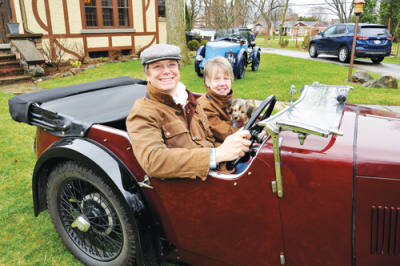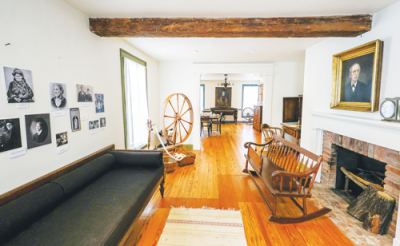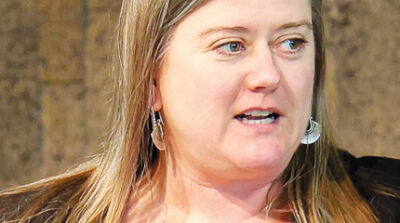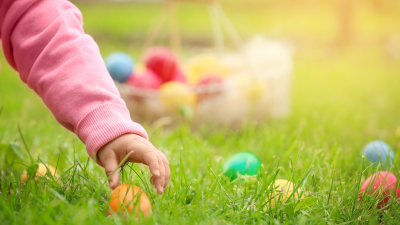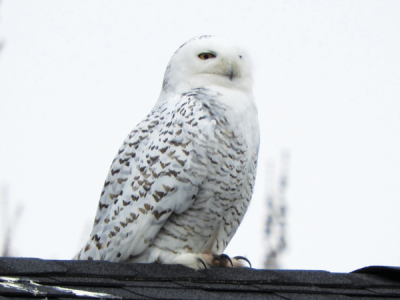
A snowy owl, spotted in St. Clair County, is a raptor that migrates to Michigan during the winter.
Photo by Barb Baldinger
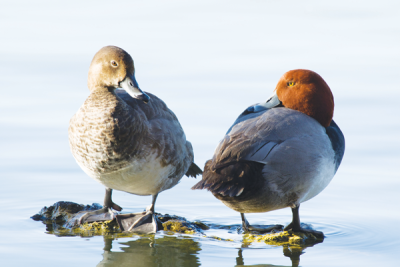
Female, left, and male redhead ducks are one species of waterfowl that migrates to Michigan during the winter.
Photo by Lynette Spence, provided by Audubon Great Lakes
METRO DETROIT — As the air chills and days get shorter, it’s common for snowbirds to take their flights south.
But while our senior set heads for the Florida coast, some of nature’s feathered fellows find their way to Michigan from the Arctic.
These seasonal guests from the high north, along with being interesting company, make the winter a fascinating time for dedicated birders.
“A lot of people don’t necessarily think of a lot of birds being around in the winter,” said Stephanie Beilke, senior manager of conservation science at Audubon Great Lakes. “You hear more birds singing in the spring and summer and there’s more obviously around, but in the winter there’s still a lot of bird activity in Michigan.”
Winter birders keep their eyes out for a number of unique birds. Raptors, notably the snowy owl and various hawks, are some of the most famous winter birds. Another unique winter sight is the arrival of “weird ducks” with striking feather and beak patterns. Notable winter ducks include the bufflehead, northern pintail, common goldeneye and the ruddy duck.
“They’re looking for anywhere that just has open water because that’s all they need to find food,” Beilke said. “They’re looking for fish or plants that are underwater.”
Small birds, too, make southerly journeys for the warmer weather of frigid Michigan. Those birds, like the dark-eyed junco, can be best spotted at properly-equipped bird feeders — one of the least chilly ways of winter birding. Finches also may make an irruptive migration south due to what kind of seed crops have grown over the year.
“True sparrows … like the dark-eyed junco like to feed on platforms, so getting a tray feeder or a larger hopper feeder where you’ve got an edge to it that they feel comfortable sitting on,” said Rosann Kovalcik, owner of the Wild Birds Unlimited in Grosse Pointe Woods.
Some bird feeders are enjoyed by being directly watched, while others use technology to catch visiting birds with camera feeders.
“What’s good about them is that you can be in your house, you can have the camera set to be transmitting to your laptop or your phone and you can take pictures from that to help identify (birds),” Kovalcik said. “The camera feeder that we sell actually has identification built in it. There’s a huge surge of that going on. There’s still probably a much larger group of people that go out and they just want to look with their binoculars and they’re just getting into the hobby.”
For those looking to get more outdoors but still close to heat, car caravans organized by Audubon and Bird Alliance groups are a great way to seek birds out.
“What’s fun is just the discovery,” Kovalcik said. “What could I possibly see as I’m driving through this area of Macomb County near Algonac, and that day (Dec. 20, 2024) my partner and I had a screech owl, we had a bald eagle, we had a red-shouldered hawk, red-tailed hawk, northern harrier. We had so many raptors that we could see that were out during the day or you could play tapes of and they’d call back. It’s such a treat to come across that and to see it and to know that I’m only going to get this (experience) this time of year.”
Locations close to water — such as Lake St. Clair Metropark, Belle Isle and almost anywhere along the Detroit River/Lake St. Clair coast — offer a wide variety of bird-sighting opportunities due to optimal plants and prey. Wooded areas like the non-coastal Metroparks offer great opportunities to view birds. Kovalcik says not to discount open fields, such as in northern Macomb County, when planning your winter bird watch; songbirds like snow buntings will take to open fields to scour about for seeds and insects.
“And flying over them would be short-reared owls, which are also out because they are looking for voles and mice in the same fields,” Kovalcik said.
Those with technology on their side can stay up to date on the latest bird sightings throughout the region.
“(The website) eBird is a great resource for finding birding locations called eBird Hotspots, which provide up-to-the-minute information on the very best locations and what has been seen there,” Barb Baldinger, long-time birder and former vice-president of the Macomb Audubon Society, said via email. “Another place to check is the St. Clair-Macomb Birding Trail website, which has information about 38 bird viewing sites in St. Clair and Macomb counties.”
While coming across an exotic bird can be a cool experience, it is best for the birds to keep your distance.
“One of the best things to remember is to use good birding ethics to keep your distance from any owl or other sensitive species,” Baldinger said via email. “Using your vehicle as a photo blind, if possible, is much less intrusive than walking too close to an owl and perhaps causing it to fly, when it needs to conserve energy.”
The largest birding event of the winter is the Audubon Christmas Bird Count, which runs from Dec. 14-Jan. 5 every year. Groups like the Detroit Bird Alliance, the Oakland Bird Alliance and the Macomb Audubon Society organize field trips throughout the season.
 Publication select ▼
Publication select ▼

